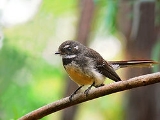
Grey Fantail
Encyclopedia
The Grey Fantail is a small insectivorous bird. A common fantail
found in Australia
(except western desert areas), New Guinea
, the Solomon Islands
, Vanuatu
and New Caledonia
. The species is considered by many to conspecific with (the same as) the New Zealand Fantail
(Rhipidura fuliginosa)., however due to differences in its calls some authorities now treat it as a separate species.
During waking hours the bird is almost never still. It flits from perch to perch, sometimes on the ground but mostly on the twigs of a tree or any other convenient object, looking out for flying insects. The birds are not shy, and will often flit within a few metres of people, especially in forested areas and suburban gardens. In doing so, it is able to catch any small flying insects that may have been disturbed by human activities such as walking or digging.
The bird's call is an almost metallic "cheek", either as a single sound or (more often) repeated as a chattering.
Fantail
Fantails are small insectivorous birds of southern Asia and Australasia belonging to the genus Rhipidura in the family Rhipiduridae...
found in Australia
Australia
Australia , officially the Commonwealth of Australia, is a country in the Southern Hemisphere comprising the mainland of the Australian continent, the island of Tasmania, and numerous smaller islands in the Indian and Pacific Oceans. It is the world's sixth-largest country by total area...
(except western desert areas), New Guinea
New Guinea
New Guinea is the world's second largest island, after Greenland, covering a land area of 786,000 km2. Located in the southwest Pacific Ocean, it lies geographically to the east of the Malay Archipelago, with which it is sometimes included as part of a greater Indo-Australian Archipelago...
, the Solomon Islands
Solomon Islands
Solomon Islands is a sovereign state in Oceania, east of Papua New Guinea, consisting of nearly one thousand islands. It covers a land mass of . The capital, Honiara, is located on the island of Guadalcanal...
, Vanuatu
Vanuatu
Vanuatu , officially the Republic of Vanuatu , is an island nation located in the South Pacific Ocean. The archipelago, which is of volcanic origin, is some east of northern Australia, northeast of New Caledonia, west of Fiji, and southeast of the Solomon Islands, near New Guinea.Vanuatu was...
and New Caledonia
New Caledonia
New Caledonia is a special collectivity of France located in the southwest Pacific Ocean, east of Australia and about from Metropolitan France. The archipelago, part of the Melanesia subregion, includes the main island of Grande Terre, the Loyalty Islands, the Belep archipelago, the Isle of...
. The species is considered by many to conspecific with (the same as) the New Zealand Fantail
New Zealand Fantail
The New Zealand Fantail is a small insectivorous bird. A common fantail found in the South Island of New Zealand, also in the North Island as subspecies Rhipidura fuliginosa placabilis, the Chatham Islands as Rhipidura fuliginosa penita and formerly the Lord Howe Island as Rhipidura fuliginosa...
(Rhipidura fuliginosa)., however due to differences in its calls some authorities now treat it as a separate species.
Description
This Fantail is mid to dark grey or grey-brown above, lighter (often yellowish/orange) below, with a white throat, white markings over the eye, and (depending on the race) either white-edged or entirely white outer tail feathers. It grows to 16 centimetres in length, of which half is the tail, which, as the name implies, is often displayed fanned out. This reveals that the outer tail feathers that are light and the centre ones are dark. Some subspecies are found in a darker plumage.During waking hours the bird is almost never still. It flits from perch to perch, sometimes on the ground but mostly on the twigs of a tree or any other convenient object, looking out for flying insects. The birds are not shy, and will often flit within a few metres of people, especially in forested areas and suburban gardens. In doing so, it is able to catch any small flying insects that may have been disturbed by human activities such as walking or digging.
The bird's call is an almost metallic "cheek", either as a single sound or (more often) repeated as a chattering.
Life cycle
The Grey Fantail is territorial and it is a seasonal breeder. The birds form compact, cup-shaped nests, usually in the forks of trees, made from moss, bark and fibre, and often completed with spider's web. They raise several broods per season, usually each of 3-4 cream eggs spotted grey and brown. Incubation period is around two weeks, and incubation and feeding duties are shared by both adults.External links
- Grey Fantail videos on the Internet Bird Collection

